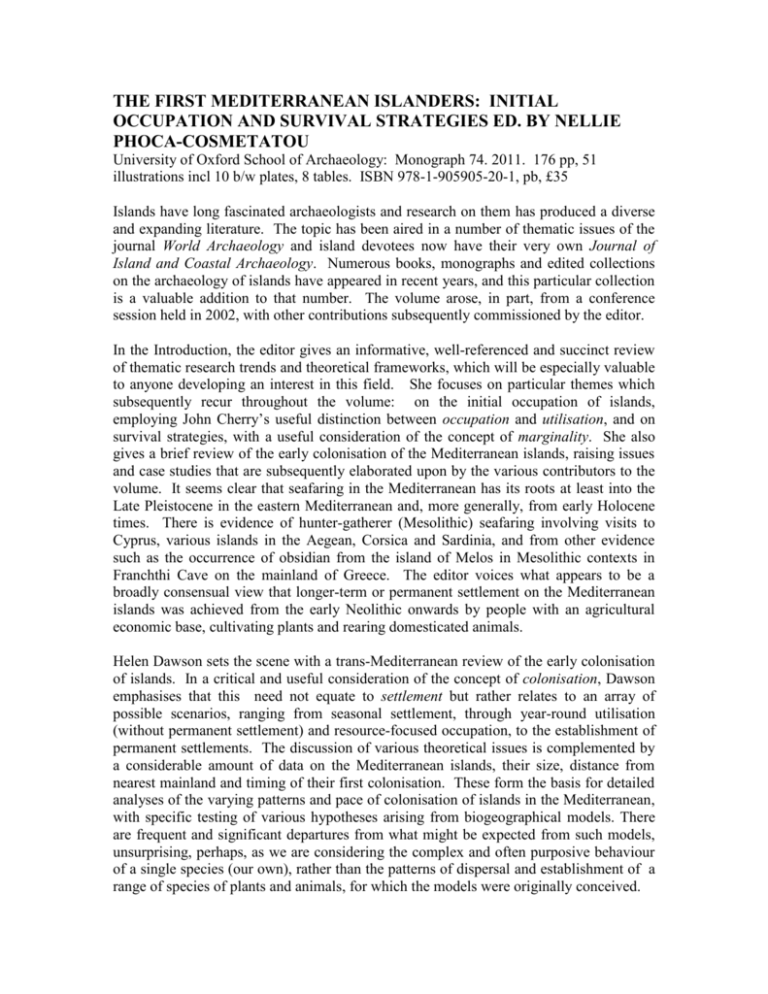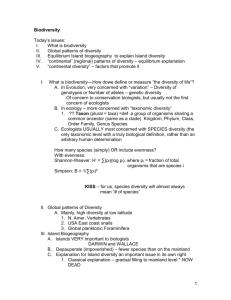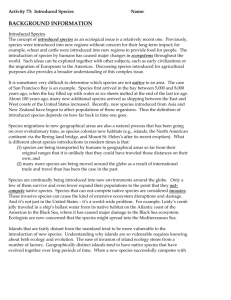THE FIRST MEDITERRANEAN ISLANDERS: INITIAL OCCUPATION
advertisement

THE FIRST MEDITERRANEAN ISLANDERS: INITIAL OCCUPATION AND SURVIVAL STRATEGIES ED. BY NELLIE PHOCA-COSMETATOU University of Oxford School of Archaeology: Monograph 74. 2011. 176 pp, 51 illustrations incl 10 b/w plates, 8 tables. ISBN 978-1-905905-20-1, pb, £35 Islands have long fascinated archaeologists and research on them has produced a diverse and expanding literature. The topic has been aired in a number of thematic issues of the journal World Archaeology and island devotees now have their very own Journal of Island and Coastal Archaeology. Numerous books, monographs and edited collections on the archaeology of islands have appeared in recent years, and this particular collection is a valuable addition to that number. The volume arose, in part, from a conference session held in 2002, with other contributions subsequently commissioned by the editor. In the Introduction, the editor gives an informative, well-referenced and succinct review of thematic research trends and theoretical frameworks, which will be especially valuable to anyone developing an interest in this field. She focuses on particular themes which subsequently recur throughout the volume: on the initial occupation of islands, employing John Cherry’s useful distinction between occupation and utilisation, and on survival strategies, with a useful consideration of the concept of marginality. She also gives a brief review of the early colonisation of the Mediterranean islands, raising issues and case studies that are subsequently elaborated upon by the various contributors to the volume. It seems clear that seafaring in the Mediterranean has its roots at least into the Late Pleistocene in the eastern Mediterranean and, more generally, from early Holocene times. There is evidence of hunter-gatherer (Mesolithic) seafaring involving visits to Cyprus, various islands in the Aegean, Corsica and Sardinia, and from other evidence such as the occurrence of obsidian from the island of Melos in Mesolithic contexts in Franchthi Cave on the mainland of Greece. The editor voices what appears to be a broadly consensual view that longer-term or permanent settlement on the Mediterranean islands was achieved from the early Neolithic onwards by people with an agricultural economic base, cultivating plants and rearing domesticated animals. Helen Dawson sets the scene with a trans-Mediterranean review of the early colonisation of islands. In a critical and useful consideration of the concept of colonisation, Dawson emphasises that this need not equate to settlement but rather relates to an array of possible scenarios, ranging from seasonal settlement, through year-round utilisation (without permanent settlement) and resource-focused occupation, to the establishment of permanent settlements. The discussion of various theoretical issues is complemented by a considerable amount of data on the Mediterranean islands, their size, distance from nearest mainland and timing of their first colonisation. These form the basis for detailed analyses of the varying patterns and pace of colonisation of islands in the Mediterranean, with specific testing of various hypotheses arising from biogeographical models. There are frequent and significant departures from what might be expected from such models, unsurprising, perhaps, as we are considering the complex and often purposive behaviour of a single species (our own), rather than the patterns of dispersal and establishment of a range of species of plants and animals, for which the models were originally conceived. Some of the earliest evidence of human colonisation of islands in the Mediterranean comes from Cyprus, as discussed by Alan Simmons with special reference to the rockshelter of Akrotiri-Aetokremnos, which has evidence of human occupation in the 11th millennium BC. The site contains artefacts along with the remains of over 500 pygmy hippos, which were a striking component of the species-poor Pleistocene mammalian fauna of Cyprus. There is controversy over the claimed relationship between the human occupation of the rockshelter and the remains of so many hippos. Simmons and his colleagues assert that the hippos were hunted during this so-called Akrotiri Phase of human occupation of Cyprus but other scholars have disputed this on various grounds, including problems of stratigraphy and chronology, and the absence of cut marks on the hippo bones. Simmons rebuffs some of these criticisms, but accepts that, of over 30 palaeontological sites known on Cyprus, this is the only one so far with evidence of human presence. Aside from this dispute, Simmons suggests that the Akrotiri Phase is unlikely to represent a permanent human occupation of Cyprus but points to a series of PPNB (Pre-Pottery Neolithic B) sites recently excavated on the island and some recentlydiscovered sites of PPNA character which will lead to a major revision of the early chronology of human cultures on the island. Simmons provides a useful synopsis of what is known of the PPNB sites, in particular their economic implications in terms of domesticated plants and animals introduced to the island from the Near East. There is a particularly interesting discussion of the surprisingly early occurrence of domesticated cattle at PPNB sites on the island. Equally enigmatic is the absence of domesticated cattle from Cyprus during the Cypriot Neolithic phase, with their re-appearance at the beginning of the Bronze Age. It is not possible, here, to go into the range of arguments rehearsed by Simmons to account for the complexities of early human occupation and economies on Cyprus, but it all makes compelling reading. This article, and others in this volume, demonstrates that, rather than being mere vessels receiving cultural overflow from mainland areas, the Mediterranean islands were dynamic arenas for cultural change and adaptation. By contrast, the Cycladic islands have a markedly different trajectory of visitation and colonisation, as discussed by Nellie Phoca-Cosmetatou. Although these small and dry islands were visited in all major cultural phases since the Upper Palaeolithic, there is no clear evidence of permanent settlement until the Late Neolithic. Phoca-Cosmetatou considers the evidence for this first settlement and the survival strategies adopted in these marginal environments with low natural resource diversity. Why were they settled so late, or even at all? Following a discussion of a diverse range of possible underlying factors, both environmental and socio-cultural, she suggests that a principal factor in the success of the settlers was a greater reliance in the animal economy on sheep and goats, which are better adapted to the open and more arid landscapes of these islands than are cattle. The island of Palagruža and its potential role in the spread of farming in the Adriatic is considered by Stašo Forenbaher and Timothy Kaiser. Palagruža is one of the few islands in the Adriatic which has been an island throughout the Pleistocene and Holocene, most of the others were once hills or mountains of the mainland, becoming islands as a consequence of rising sea levels in the early Holocene. Palagruža is a very small (0.3 sq km), craggy, dry and remote island in the middle of the Adriatic sea, the earliest evidence of human presence being pottery of the Early Neolithic. It appears unlikely that the island was actually settled in Neolithic times, but could have been visited for the exploitation of fish resources and its fine-quality chert deposits. It is also possible that, owing to its central location, the island was an important and useful landfall location for trans-Adriatic seafarers and could therefore have been part of a route for the spread of farming from south-east Europe, across the Adriatic and into southern Italy. Some of the most compelling evidence for early and widespread trade, exchange or distribution of resources between islands and also mainland localities comes from raw materials, such as obsidian, with characteristic mineralogical signatures which can be sourced to a specific locality. This is discussed by Elena Castagnino Berlinghieri in relation to the island of Lipari, one of the volcanic Aeolian Islands which are clearly visible from the north-east coast of Sicily. Castagnino Berlinghieri considers at length the nature of Neolithic presence on the island, and patterns and mechanisms of trade or exchange that have caused the obsidian from Lipari to have such a widespread distribution in the western and central Mediterranean, deploying ethnographic analogues such as Australian Aboriginal exchange systems and Polynesian seafaring equipment and techniques of maritime exploration. She speculates that from the Early Neolithic, the island of Lipari could have been a focal point for the convergence of people not only to acquire obsidian but also to exchange ritual gifts or diverse specialised products. In contrast to Lipari, Malta has no mineral resources that might have attracted early visits or settlers and, as discussed by Anthony Bonanno, it is likely that Malta was not settled until around 5000 BC. Malta does, however, have excellent limestone suitable for building and a layer of blue clay between the limestone formations creates an aquifer providing plentiful freshwater. In environmental terms, Malta is highly suitable for agriculture. The early settlers appear to have come from south-eastern Sicily, as suggested by the Stentinello-type pottery found at early sites on Malta. Sea-going craft must have been sufficiently large and stable to permit the transport of domesticated animals across the 90 km of sea between Sicily and Malta. It is probable the settlers kept up their contacts with Sicily, with high quality flint and obsidian (the latter from sources on the islands of Lipari and Pantelleria) continuing to reach Malta through the Neolithic period. In the later Neolithic (4400-4100 BC), cultural divergences become apparent, most notably in religious or cultic practices as evidenced by feminine figurines that are unknown in Sicily at this time. Shortly after, there was a complete change in the types of ceramics being produced but with no apparent evidence of an interruption in occupation. The new pottery types are similar to those of contemporary cultures in eastern Sicily and Bonanno suggests this might indicate a new influx of population into Malta. Shifting the spatial scale quite dramatically, Atholl Anderson considers island colonisation from the perspective of Oceania, where the distances involved are vastly greater than for the Mediterranean. In a fascinating discussion, in which the issues and arguments are presented with great clarity, Anderson concludes that a principal difference with the Mediterranean is that Oceania was a wholly insular region in which prehistoric exploration and colonisation occurred with no involvement of the continental margins. Another important point, which is also highlighted by Chris Gosden in a thought provoking over-view of the entire volume, is that Polynesian culture (material culture, language, mythology) remained unified over a huge area, while diversity is the keynote characteristic of the earliest settlements on islands in the Mediterranean. Gosden observes that the concept of ‘the Mediterranean’ as a culture zone has been shaped by events from the Bronze Age onwards. Before this, we are looking at numerous, distinct, ‘small worlds’ in which things happened locally, creating “a mosaic of forms of life in which the individual tesserae were more important than any overall pattern” (p. 176). This is clearly demonstrated by the various contributions to this most interesting and useful compilation. Kenneth D. Thomas Institute of Archaeology University College London May 2012 “The views expressed in this review are not necessarily those of the Society or the Reviews Editor”







